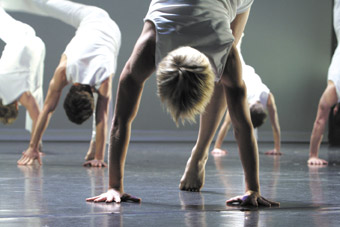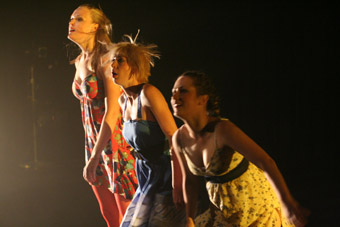 |
Dance students from the Faculty of Creative Industries, QUT |
Both types of bodies populate higher education, at times in tense relationships, at other times in articulate and consummate partnerships. Few scholars in the 21st century would deny the gap between ‘being’ and its pervasive representations and yet the movements of dance within the halls of academe often meet with resistance, as if dance was the shadowy substance and its representative descriptions—like these words—the measure of its validity.
News of the academic dancing body, however, is not all woe. Practice-based knowledge or epistemological materiality has been recognised in the Australian research community, specifically in a Creative Arts’ Panel of the Research Quality Framework, the present government’s new mechanism for research funding, and that is a huge step for a discipline all too often considered frivolous and/or dangerous or, at the least, victim of its unavoidable vanishing.
Nonetheless, the debate continues in part due to semantic habits—artists clinging tenaciously to intuition, scholars to rigorous methodologies where the two might interchange or fuse, artists through the rigour of their methods, scholars through intuitive ‘what ifs.’ Dismantling preconceptions seems apt for a discipline whose contemporary history is permeated with fall and recovery investigations, stretching back to modern dance pioneers like Rudolf Laban and Doris Humphrey. This tradition of challenge is not to be taken lightly. Questions about where, within practice-based experiments, original discovery lies and how it is to be articulated, understood and judged form the subject matter of a Carrick Institute for Teaching and Learning in Higher Education grant, awarded to collaborators from the Queensland University of Technology, Deakin University and the WA Academy of Performing Arts in conjunction with the Tertiary Dance Council of Australia and Ausdance. The tilts and twists of physical research are advancing, pushing cumulatively in the wake of Shirley McKecknie and Kate Stevens’ ARC-funded explorations into choreographic processes and the reception of contemporary dance.
 |
Dancers, UNSW School of English, Media & Performing Arts photo Su Goldfish |
Other institutions, the Wesley Institute, the Australian Centre of Physical Education and the University of NSW, concentrate on alternative pathways in dance therapy, education or arts management/policy. At the elite level, training has to take advantage of peak physical capacities to attain the space hurtling and angular buckling of contemporary dance or the effortless flight and balance of ballet. Virtuosic youth is less necessary for teaching, healing and guiding, although each of these occupations depends conceptually on the daring embodiment of performer and energy-shifter. Other complications arise for these complementary careers, such as requirements of literacy and numeracy standards, strategies for special needs students, technological integration and behavioural management skills dictated by the newly formed NSW Institute of Teachers which leave little time for intensive content development. The disciplinary task, as dance lecturer Jacqui Simmonds observes, “is to assist students to appreciate dance as a continually evolving art form that extends beyond the framework of the NSW Board of Studies Dance syllabuses while honouring the philosophy and content of those syllabuses.” Her comments resonate with tensions of information overload and the fluctuating political rhetoric between monologic learning and plural specialisations which, differently expressed, reflects the University of Melbourne’s model.
One coup for dance, enabled by the arguably vocational focus of the postgraduate model, is the announcement of a new postgraduate program in dance science to be offered at the VCA in 2008. The course is designed for dance and health science professionals interested in expanding their understanding of the science of dance movement and in improving dancers’ well-being and training. Another niche development emerges through Deakin University’s recently unveiled Motion.Lab, one of a handful of motion capture studios world-wide available to dance students, artists and researchers, projecting an innovative vision that embraces both under- and postgraduate streams. While steering dance into digital engagements, the Motion.Lab’s singularity also lies in its commercial alignment with animation and game development industries through the university’s industry partner, Act3animation.
The University of NSW’s introduction of specific practice-based PhDs in the School of English, Media and the Performing Arts concurs with the higher degree opportunities pattern. However, the same institution’s struggle to come to grips with dance at an undergraduate level reveals an awareness of young dancers’ needs and touches Sydney’s raw nerve as the only state capital without an established dance training course. UNSW’s long-standing Dance Education degree has been reviewed in the light of this thorny issue, exacerbated by the recent closure of the BA Dance at the University of Western Sydney. Recommendations have yet to be actioned though there is a prevailing optimism about UNSW’s capacity to offer an undergraduate course that, while not duplicating the elite situations at QUT, VCA and WAAPA, could lead active and committed students to a variety of performing and/or dance-making careers. Accented liberal arts, modelled on programs in the US and Europe which aim at a fusion of dancing and discursive bodies, propel UNSW’s vision. Whether this fusion works for students is yet to be tested.
In conversation with Su Goldfish of UNSW’s production unit, another crucial point emerged, the mutual benefits of crossing the arts with university structures. Goldfish’s unit at the Io Myers Studio has been re-shaped into a Creative Practice and Research Unit to facilitate the envisioned postgraduate activity. At the same time, existing resources (perhaps complemented by two spaces refurbished for dance) currently accommodate independent artists’ choreographic development. Dancer/choreographers such as Kate Champion, Julie-Anne Long, Martin del Amo and Sue Healey fill any available spaces with their driven pursuits. This interaction with the artistic community generates opportunities which flow both ways: artists can be employed as lecturers, their working processes in university venues can act as laboratory studies for student analysis and together artists, university staff and students can percolate culture, keeping mindful bodies alert and curious. Other institutions such as WAAPA operate in a similar way, invariably astounding visitors with the excess of movement, sound and text that spills into every niche within and outside the building. Such visitors can be the same university authorities who cut teaching weeks and strategise on-line transmission to reduce the costs of face-to-face teaching. Engagement admired in one breath is dismissed in the next.
Dance has much to gain from current postgraduate tendencies but educators have to resist the impoverishment of undergraduate offerings, support the mutual advantages of embodied campuses and, most importantly, encourage partnerships between the discursive and the fleshy. Embodiment must venture into the unknown, pushing against obstacles because, in the shuddering response, dance happens.
Maggi Phillips is Coordinator of Research and Creative Practice at the Western Australian Academy of Performing Arts [WAAPA] at Edith Cowan University.
RealTime issue #80 Aug-Sept 2007 pg. 13
© Maggi Phillips; for permission to reproduce apply to [email protected]








 back
back